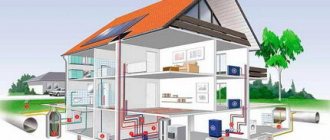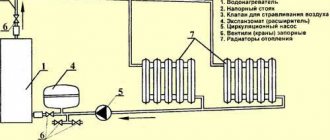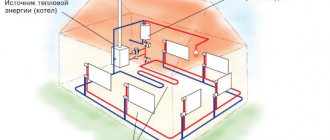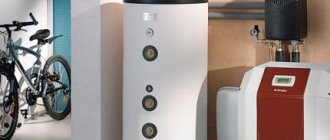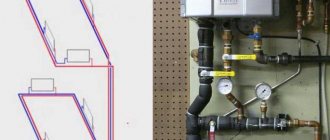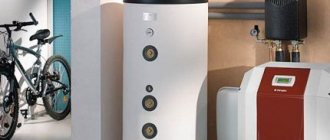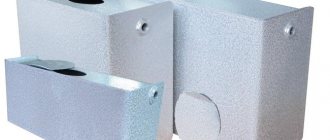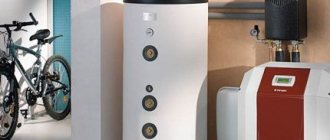Your own home is not only a personal fortress, but also a place where it is cozy and warm. For this to always be the case, a prudent owner must provide an uninterrupted supply of heat. The easiest way to do this is if you can connect to a centralized system.
However, this is not always the case, and many do not want to connect to an expensive service. In this case, it remains to consider the types of heating systems suitable for autonomous installation, and then choose the best option. And we will try to help you in this matter - our article discusses the features of water, air and infrared heating systems, listing their main pros and cons.
We have also provided useful recommendations for choosing the best option. The presented material was provided with visual diagrams, photographs and videos with reviews of these heating systems.
How to choose the best heating system?
There are many heating systems. They all have attractive sides and significant disadvantages. It is quite difficult for an unprepared person to navigate them and make the right choice. In order not to make mistakes, you need to know exactly what points you should pay attention to.
Firstly, it is the availability of fuel and its cost. This can be considered a key point. No matter how much you like the system, if the fuel for it is difficult to obtain, is supplied to the region intermittently, or is too expensive, you should consider another option. Otherwise, heating your home will cost a pretty penny and will be ineffective.
According to statistics, most owners of private houses choose heating systems with liquid coolant. This is a practical, reliable and quite economical option
The second point is the possibility of combining heating systems. In some cases, it may be very practical to use a primary and secondary system. This gives confidence that in the event of possible interruptions in energy supplies, the house will not be left without heat.
In addition, there is an opportunity to save money, since you can use the most economical heating method at the moment.
And finally, the financial side of the issue. It is necessary to determine how much the consumer can allocate for the purchase of equipment, its proper installation and subsequent regular maintenance.
Option #1 - without additional pumps and hydraulic arrows
This simple option assumes that the comb will serve several circuits (say, 4-5 radiator batteries), the temperature is assumed to be the same, and its regulation is not provided. All circuits are connected directly to the comb, one pump is used.
Connection rules and features of comb installation
The characteristics of pumping equipment must be correlated with the performance of the heating system and the pressure created in it. So that you can choose the best pump that is ideal in terms of characteristics and cost, we recommend that you familiarize yourself with the rating of circulation pumps.
Since the resistance in the circuits is different (due to different lengths, etc.), it is necessary to ensure optimal consumption of the coolant by balancing.
To do this, balancing valves, rather than shut-off valves, are installed on the return comb nozzles. They can regulate (although not exactly, but by eye) the coolant flow in each circuit.
Features of a liquid coolant system
Heating systems with coolant in the form of liquid are perhaps the most popular in our country. This is understandable, because they are familiar and quite effective. The basis of such a system is a closed-type heating circuit with a heating device, inside of which there is a heat exchanger. Liquid passes through it and heats up to the desired temperature.
Next, the coolant goes through the pipes to the heated rooms. Here it enters the radiators, where it gradually cools, giving off heat to the surrounding air. The cooled liquid moves towards the heating device, enters the heat exchanger and the cycle repeats.
Such a system is also called water heating, but this is not entirely correct, since various compounds can be used as a coolant - for example, antifreeze.
A liquid coolant system necessarily includes a pipeline through which water or antifreeze circulates, and heating devices installed in the premises
The undoubted advantage of such a system can be considered its variability. There are many different wiring schemes to ensure the most efficient heat supply for specific conditions.
There are water heating with forced and gravitational circulation. In the first case, a pump is used to supply the coolant, which makes it possible to implement circuits of varying complexity and length. The second option has many limitations, but is completely energy independent.
Heating systems with liquid coolant can be implemented in many options. This is, for example, what a two-pipe wiring diagram looks like: the coolant enters through one pipe, and out through the other
The system can be configured with one- or two-pipe wiring. The first is extremely simple and economical, but not effective enough for a large house. The second is more complex, but allows high-quality heating of buildings of any size. Depending on the type of system chosen, the set of equipment necessary for its installation also differs.
An integral element of any of them is the boiler, the type of which largely determines the operational characteristics of the system. Let's look at the most popular devices.
Option #1 - using gas equipment
A gas boiler is considered the most economical of all analogues. It works extremely simply. The gas enters the combustion chamber, where it burns, releasing heat, which is transferred to the coolant liquid through a heat exchanger.
The equipment is diverse and, accordingly, has different properties. Turbocharged equipment is considered the safest and most efficient.
It does not require the installation of a traditional chimney, does not take air from the room and has the highest efficiency.
Floor-standing varieties of gas boilers include models with maximum power. They are capable of heating 2-3-story cottages of any size
Devices with an open chamber are characterized by low efficiency and require high-quality ventilation and a traditional smoke exhaust system. At the same time, they are completely energy independent, and their cost is minimal. But it is important to install and connect the equipment correctly.
The advantages of heating with a gas boiler include the following features:
- Low fuel cost, it increases very slowly.
- High equipment efficiency.
- Possibility of full automation of the heating system.
- Cleanliness in the premises, since fuel combustion does not produce large amounts of ash and soot.
- Wide range of gas equipment.
Among the disadvantages, it is worth noting the potential danger of using gas. Great care is required when working with it. All maintenance and installation work may only be carried out by certified specialists.
In addition, special permission will be required to connect gas equipment. The cost of devices and their installation is quite high; the possibility of connecting to a gas main does not exist everywhere.
Option #2 - use of a solid fuel boiler
These are heating devices familiar to many. Their operation requires solid fuel: calibrated coal, firewood, peat, pellets, etc. The operating principle is similar to gas ones, they differ in the type of burner.
Modern modifications of long-burning are characterized by the fact that one load of fuel is enough to maintain the flame for half a day or more. The simplest models are non-volatile, require constant human control and have low efficiency.
Solid fuel boilers are not always easy to use. The simplest models require constant fuel loading, frequent cleaning and maintenance
Improved devices can be equipped with automated control and automatic fuel supply. True, the latter applies to pellet equipment. Such devices, when connected correctly, are quite effective and reliable.
The advantages of solid fuel equipment are:
- Simplicity and reliability of the design, which significantly extends its service life.
- The budget cost of the equipment and the possibility of carrying out its installation and subsequent maintenance yourself.
- There is no need to obtain special documentation for the installation of such a boiler.
- A wide selection of devices with different functionality and power.
The equipment also has significant disadvantages. First of all, this is the need to create a fuel reserve, which must be stored in proper conditions. Solid fuel boilers, especially their simplest modifications, are not very easy to use. There is a large amount of soot and soot, so very frequent cleaning of the device is required. In addition, you will also have to load fuel quite often.
Option #3 - using an electric boiler
You can also heat the coolant in the system using electric boilers. It is generally accepted that this is a very uneconomical method. However, this is not quite true. You need to understand that several types of electrical equipment with different characteristics are produced.
Heating element and electrode models
Heating element models are the simplest and most ineffective. They heat the coolant using tubular electric heaters lowered into it. The devices consume a large amount of electricity with a relatively low efficiency. At the same time, the heating elements in the liquid fail quite quickly.
Electrode boilers are more economical and reliable. In them, the coolant moves inside the boiler, where two electrodes are installed. When an electric current is applied, the liquid heats up very quickly.
Electrode boilers are compact and efficient. Thanks to their design, they are very durable and can last for decades.
Induction boiler type
The most efficient and economical type of electrical equipment is induction boilers. Thanks to the presence of two circuits, magnetic and thermal, they manage to heat the coolant liquid as quickly as possible.
The advantages of all types of heating devices include:
- Quick heating of the coolant and, accordingly, the room.
- Compact equipment.
- Simple installation, which is carried out without first obtaining permission.
- No chimney installation is required.
- Comfortable operation, possibility of equipping with automatic control.
- Complete safety and environmental friendliness.
Among the disadvantages, the rather high cost of operation is usually noted, which is a consequence of the high price of energy.
True, depending on the type of boiler and the presence or absence of automated system control, heating costs can vary significantly. Induction boilers, fully equipped with automation, are quite economical and pay for themselves quite quickly.
Combined heating boilers
On sale you can find combination heating boilers that can operate with several types of fuel. These are more expensive devices, the main advantage of which is the ability to provide the house with heat in conditions of interruptions in the supply of the main type of fuel.
A combined or multi-fuel boiler is a universal heating device, indispensable for areas where there are interruptions in the supply of different types of fuel
The common advantages of all heating systems with liquid coolant are low cost and availability, fairly high efficiency and many design options.
The disadvantages include not the most comfortable temperature distribution in the rooms. Warm air is at the top and cooler air is at the bottom.
In addition, water systems fail if the temperature in the building drops below freezing. Systems with antifreeze and saline solutions do not have this drawback. However, antifreezes are expensive and toxic, and salt solutions provoke rapid corrosion of the system.
Which pipe layout is best for a private home?
The type of pipe routing will depend on the type of circulation provided for by the project. Common options include systems:
- With natural circulation.
- With forced.
Depending on the number of risers, a one- or two-pipe installation scheme can be used. And the connection diagram can be either horizontal or vertical. There are many options for pipe routing; it is better to consult with specialists to choose the right one.
Air heating of the building
This is another type of heating for a private home. Its main distinguishing feature is the lack of coolant. The air system is designed in such a way that air flows pass through a heat generator, where it is heated to the desired temperature.
Then, through special air ducts, which can have very different shapes and sizes, the air masses are directed to the heated rooms.
To heat a large private house, you can use air heating, while it is possible to create a comfortable microclimate in each room
According to the laws of convection, heated flows rise, cooled ones move down, where holes are mounted through which air is collected and removed to the heat generator. The cycle repeats.
Such systems can operate with forced and natural air supply. In the first case, a pump is additionally installed to force the flow inside the air ducts. In the second, air movement occurs due to temperature differences. It is clear that forced circulation systems are more efficient and powerful. We talked about arranging air heating with our own hands in the next article.
Heat generators also differ. They can run on a wide variety of fuels, which determines their performance characteristics. Gas, electric and solid fuel appliances are most in demand. Their disadvantages and advantages are close to similar water heating boilers.
The circulation of air masses inside a building can be carried out in different ways. This can be a closed cycle without adding air from outside. In this case, the indoor air quality is poor.
The best option is circulation with the addition of air masses from outside. An undeniable advantage of air heating is the absence of coolant. Thanks to this, it is possible to save the energy needed to heat it.
In addition, the installation of a complex system of pipes and radiators is not required, which undoubtedly also increases the efficiency of the system. The system does not have the risk of leaks and freezing, like its water counterpart. It is ready to work at any temperature. The living space heats up extremely quickly: literally, about half an hour passes from starting the heat generator to raising the temperature in the rooms.
A gas heat generator is one of the possible solutions for implementing an air heating project for a private house. But in practice such systems are rarely used
Another significant plus is the ability to combine air heating with ventilation and air conditioning. This opens up the widest possibilities for creating the most comfortable microclimate in the building.
The air duct system can be successfully used for air conditioning rooms in the summer. Installing additional equipment will make it possible to humidify, purify and even disinfect the air.
Air heating equipment lends itself well to automation. “Smart” control allows you to remove burdensome control over the operation of appliances from the homeowner. In addition, the system will independently select the most economical operating mode. Air heating is very easy to install and durable. Its average service life is about 25 years.
Air ducts can be installed during the construction phase of the building and hidden under the ceiling covering. Installation of such systems requires high ceilings
The advantages include the absence of pipes and radiators, which gives room for the imagination of designers who design the interior. The cost of such a system is quite affordable for most homeowners. Moreover, it pays off quite quickly, so its demand is growing.
Air heating also has disadvantages. These include a significant difference between the temperatures in the lower and upper parts of the room. On average it is 10 °C, but in rooms with high ceilings it can reach up to 20 °C. Thus, in the cold season, increased power of the heat generator will be required.
Another disadvantage is the rather noisy operation of the equipment. True, this can be mitigated by selecting special “quiet” devices. If there is no filtration system at the outlets, large amounts of dust may appear in the air.
Electricity
Separately, it is worth mentioning the electric type of heating. The word “electricity” itself has firmly entered our everyday life. The world's electricity use is approaching one hundred percent.
Therefore, as an option, you can use heating systems that run entirely on electricity. In some cases, it may be advisable to install, for example, electric floor heating, heated towel rails in bathrooms, and small radiators.
However, electricity is constantly rising in price, and this factor must be taken into account when installing electric heating devices rationally. It is also especially important to observe electrical safety measures and install such equipment with the help of qualified specialists.
Infrared heating system
This is a relatively new method of heating residential buildings. It is based on the use of infrared radiation. Scientists have found that infrared rays can have different lengths. Long-wave radiation, similar to what we receive from the Sun, is safe and even beneficial for humans. It is used in heating devices operating in the infrared range.
Infrared film heaters can be mounted on the ceiling. Then the radiation will fall down and reach the floor, which will begin to warm up
For heating premises, a special infrared film is used. A thin layer of carbon paste is applied to a non-woven base, which is activated under the influence of current and emits infrared waves. The resulting emitter is laminated on both sides with a film, which gives it strength and extends its service life.
The operating principle of infrared heating is as follows. The film is placed on the floor or on the ceiling. When the system is turned on, current is applied to the emitter and it produces infrared waves. They move and reach the first massive obstacle. This can be large furniture, household appliances, and most often the floor. Such objects are impenetrable to infrared rays; they are retained and accumulated in them.
Objects gradually heat up and release the resulting heat into the air, due to this the room warms up very quickly. In another article, we talked in more detail about installing infrared heating with our own hands.
It must be admitted that this type of heating is the most comfortable. Due to the fact that the floor is heated, the temperature distribution is as pleasant and beneficial for humans as possible. The lower part of the room is about 2-3 °C warmer than the upper part.
In addition, natural humidity and the amount of oxygen are completely preserved, and there are no convection currents that carry dust. There are no drafts either. Film heaters operate absolutely silently and are safe for humans.
If infrared heaters are placed under the floor covering, the radiation rises up, reaches the floor and heats its surface, and then the air in the room
Another advantage is fully automated system control. This allows it to operate in the most economical mode and at the same time provide the owner with complete comfort. Thanks to this, the film system has no heat losses and its efficiency is almost 100%.
The minimum service life of the equipment is 25 years, and the service life is twice as long. In this case, the system does not require maintenance.
The next advantage is compactness. The film is very thin and does not “eat up” the free space. No additional room is required for the heating unit; there are no batteries or air ducts. The film is very easy to install and connect. If necessary, dismantling and reuse is possible.
Among the disadvantages, it is worth noting that as the voltage drops, the amount of heat generated by the film decreases. In this case, the operating time of the heater increases, which leads to greater energy consumption. The film can be covered with a variety of finishing coatings, except putty, wallpaper and paint. The cost of equipment for installing infrared heating is quite high.
Electrical
Electric heating involves the use of infrared heaters, electric convectors or underfloor heating.
This option is less economical than gas heating, as the cost of electricity is high. It is best to use it only when other options are not available.
Advantages and disadvantages
Among the positive aspects of using such a heating system are:
- the ability to use an electric boiler to heat various liquids;
- low costs for purchasing an electric heating system;
- no need for operational maintenance;
- an environmentally friendly way to maintain the desired temperature in a room;
- the ability to simultaneously install hot water supply along with the heating system.
Electric heating also has disadvantages. Power consumption sometimes reaches 24 kW/hour. Such heating is subject to increased safety requirements. Power outages disrupt the system. Certain inconveniences are caused by the need to install a multiphase distributor, since many electrical networks cannot withstand high voltage. Good thermal insulation of the house is also necessary.
Consumption
Example No. 3. Calculation of electricity consumption. Let's assume that the area of the house is 100 m². To heat it, you will need a 10 kW unit (1 kW per 10 m² of area). The number of months in the heating season is 7.
- Monthly fuel consumption: 10 kW *24 hours* 30 days = 7200 kW.
- Average value: 7200 / 2 = 3600 kW.
- Annual fuel consumption: 3600 kW * 7 months = 25200 kW. Let's convert the resulting value into m³: 25200/10 = 2520 m³.
- Monetary value: 2520 * 4.97 = 12524, 40 rubles per year.
LPG boilers
In terms of efficiency, this method of economically heating homes is better than using natural gas. But you need to take into account the nuances. It was they who prevented liquefied gas from becoming in demand as an economical heating method:
- For storage, a container is purchased - a gas holder. The larger its volume, the less often you need to order gas delivery.
- The tank is buried in the ground, which can cause difficulties due to the size of the tank.
- You will have to select a location not only based on the characteristics of the soil for digging, but also on the possibility of access by a refueling vehicle.
The costs here are high, because the gas tank is expensive. But this economical method is popular. Once the purchased installations pay off, monthly financial expenses for heating the house will be slightly inferior to natural gas.
Full autonomy. The owner must initially enter the appropriate settings. From now on, everything will function without human guidance. The main thing is to replenish the container with liquefied fuel in a timely manner.
Liquefied gas is an alternative to natural gas. If you have the financial opportunity, it is worth purchasing components and carrying out installation in accordance with the requirements. As a result, you can get affordable, safe heating of a country house.
general information
In the absence of gas supply, owners use other economical methods of heating their houses. Several alternatives are used. They differ radically in the organization of the system and in cost.
When choosing an economical method of heating a house, you need to rely on the following criteria:
- climate;
- maximum sub-zero temperature;
- budget.
Based on these parameters, a suitable economical option for providing heat in the house is selected. There are many effective heating methods. Here's some brief information about each of them.
Solid fuel boilers
One of the traditional and economical ways. The heating system is similar in design to the one with a gas boiler. It is distinguished by the installation of a heat generator that runs on solid fuel.
This method of economical home heating has the following features:
- fuel is added to the stove once a day;
- For long-term heating, choose equipment with a long-burning function.
Such models not only provide comfort, but are economical, as they slowly consume peat briquettes or ordinary firewood.
The most economical way is considered to be a pellet boiler. These are small wood pellets that the home owner pours into the tank. After that, they are fed in portions, using automation, into the boiler. Thanks to this, a person does not need to add fuel to the tank every day.
An additional feature of fuel tanks is the presence of a capital chimney. It is important not just to arrange such an element in the structure. It is required to periodically clean it of soot.
Heating using boilers requires wood or peat. Accordingly, this economical method is ideal for residents of those regions where the price for this type of fuel is acceptable.
Heating a house using solid fuels is inexpensive, but troublesome in terms of maintenance. If you buy equipment that does not support long-term combustion, you will have to heat it a little more often, the amount of wood spent will be decent.
